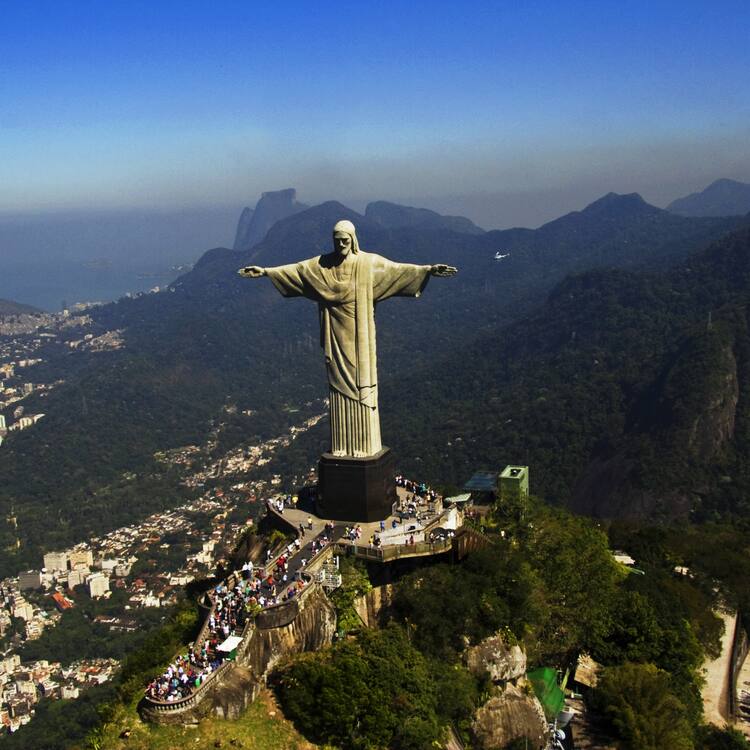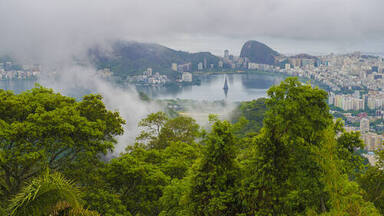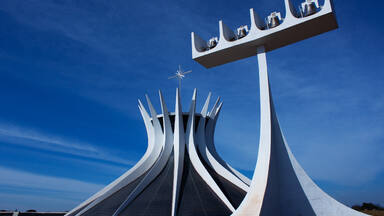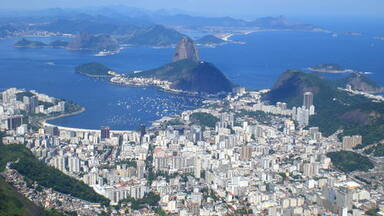Rio de Janeiro: Carioca Landscapes between the Mountain and the Sea
Rio de Janeiro: Carioca Landscapes between the Mountain and the Sea
The site consists of an exceptional urban setting encompassing the key natural elements that have shaped and inspired the development of the city: from the highest points of the Tijuca National Park’s mountains down to the sea. They also include the Botanical Gardens, established in 1808, Corcovado Mountain with its celebrated statue of Christ, and the hills around Guanabara Bay, including the extensive designed landscapes along Copacabana Bay which have contributed to the outdoor living culture of this spectacular city. Rio de Janeiro is also recognized for the artistic inspiration it has provided to musicians, landscapers and urbanists.
Description is available under license CC-BY-SA IGO 3.0
Rio de Janeiro, paysages cariocas entre la montagne et la mer
Le bien consiste en un paysage urbain exceptionnel comprenant les éléments naturels qui ont régi et inspiré le développement de la ville, partant des sommets montagneux du parc national de Tijuca pour descendre vers la mer. En font partie également les jardins botaniques, créés en 1808, le mont Corcovado avec sa statue du Christ et la chaîne de collines autour de la baie de Guanabara ou encore les vastes paysages le long de la baie de Copacabana, qui ont contribué à la culture de la vie en plein air de cette ville spectaculaire. Rio de Janeiro est aussi reconnue comme une source d’inspiration pour les musiciens, les paysagistes et les urbanistes.
Description is available under license CC-BY-SA IGO 3.0
Río de Janeiro, paisajes cariocas entre la montaña y el mar
En el sitio inscrito destaca la dimensión de la ciudad como asentamiento urbano excepcional más que el patrimonio construido que ésta contiene. Une los elementos naturales clave que han inspirado el desarrollo urbano: desde las cumbres de las montañas del Parque Nacional de Tijuca hasta el mar. Incluye también los Jardines Botánicos, creados en 1808, la cumbre del Corcovado, con su famoso Cristo, las colinas que rodean la bahía de Guanabara y los amplios paisajes de la bahía de Copacabana, escenario de la cultura viviente de esta espectacular ciudad. Con esta inscripción, se reconoce también a Río de Janeiro la inspiración artística que ha brindado a músicos, paisajistas y urbanistas.
source: UNESCO/CPE
Description is available under license CC-BY-SA IGO 3.0
リオデジャネイロ:山と海の間のカリオッカの景観
source: NFUAJ
Rio de Janeiro: Carioca-landschappen tussen de Berg en de Zee
Source: unesco.nl
Outstanding Universal Value
Brief Synthesis
The city of Rio de Janeiro, shaped by interaction with mountains and sea, lies in the narrow strip of alluvial plain between Guanabara Bay and the Atlantic Ocean. Its exceptionally dramatic landscape is punctuated by a series of forested mountains that tower over the city, rising to the uppermost peak of the Tijuca massif at 1,021 m high, and cascading down to the coast where the steep cone shapes of Sugar Loaf (Pão de Açúcar), Urca, Cara de Cão and Corcovado frame the wide sweeps of Guanabara Bay that shelters Rio de Janeiro from the Atlantic Ocean.
Cradled between these mountains and Guanabara Bay, the urban landscape of the city has been shaped by significant historical events, influenced by a diversity of cultures, is perceived to be of great beauty, and is celebrated in the arts, through painting and poetry in particular.
The property encompasses all the key natural, structural elements that have constrained and inspired the development of the city. These stretch from the highest points of the mountains of the Tijuca National Park with its restored Atlantic forest, down to the sea, and include the Botanical Gardens established in 1808, Corcovado mountain, with its statue of Christ, and the chain of dramatic steep green hills, Sugar Loaf, Pico, Leme and Glória, around Guanabara Bay, as well as the extensive designed landscapes on reclaimed land along Copacabana Bay which, together with Flamengo and other parks, have contributed to the outdoor living culture of the city.
The boundary includes all the best view points to appreciate the way nature has been shaped to become a significant cultural part of the city as well as the Guanabara Bay system of historic fortifications that gave Rio de Janeiro the character of a fortified city.
The city’s densest buildings sit on the narrow strips of alluvial land between the mountains and the sea laid out in irregular clusters of tall white blocks which contrast vividly with the green vegetation of the mountains and the blue of the sea. None of these buildings are included in the property, but a significant number are included in the buffer zone.
Criterion (v): The development of the city of Rio de Janeiro has been shaped by a creative fusion between nature and culture. This interchange is not the result of persistent traditional processes but rather reflects an interchange based on scientific, environmental and design ideas that led to innovative landscape creations on a major scale in the heart of the city during little more than a century. These processes have created an urban landscape perceived to be of great beauty by many writers and travellers and one that has shaped the culture of the city.
Criterion (vi): The dramatic landscape of Rio de Janeiro has provided inspiration for many forms of art, literature, poetry, and music. Images of Rio, which show the bay, Sugar Loaf and the statue of Christ the Redeemer have had a high worldwide recognition factor, since the middle of the 19th century. Such high recognition factors can be either positive or negative: in the case of Rio, the image that was projected, and still is projected, is one of a staggeringly beautiful location for one of the world’s biggest cities.
Integrity
The property encompass all the key natural, structural elements that have constrained and inspired the development of the city of Rio, stretching from the highest points of the Tijuca mountains down to the sea, and including the chain of dramatic steep green hills around the Guanabara Bay, as well as the extensive designed landscapes on reclaimed land around the Bay, that have contributed to the outdoor living culture of the city.
None of these elements is under threat, although the interface between these natural elements and the built-up city is vulnerable to urban pressures, the higher peaks are marred by a profusion of antennae and the Rodrigo da Freitas Lagoon (in the buffer zone) and the sea are subject to a degree of water pollution.
Authenticity
The mountains and open green areas of the Tijuca National Park, together with Corcovado and the hills around the Guanabara Bay still retain a similar combination of forest and open observation points as at the time of colonisation and allow access to vistas of the city from many high vantage points that demonstrate very clearly the extraordinary fusion between culture and nature in the way the city has developed.
The Botanical Gardens have retained their original neoclassical design with its special alignments and the fortresses keep alive the memory of the Portuguese settlements, engraved and described by the travellers that navigated the marine routes that focused on Rio de Janeiro.
The landscape designs of Burle Marx around almost the entire coast of Guanabara Bay, comprising Flamengo Park and the redesign of Copacabana beach conserve entirely the landscape morphology of their original designs and still confer high social benefits to the city.
However, in some instances elements of the designed landscape are vulnerable to incremental change – such as the paving and planting along Copacabana and Flamengo Park, where missing trees and mosaics need replacing, and in the Botanical Garden where the Imperial Palms along the main avenue are dead and need replacing.
Protection and Management Requirements
The Tijuca National Park was created by Federal Decrees in 1961. The Research Institute of the Botanical Garden was created by a federal autarchy under the auspices of the Ministry of Environment by a Law of 2001, which establishes its legal statutes, objectives, its structure of management and administration. The Pão de Açúcar (Sugar Loaf) and Urca were declared national monuments under the Law Nº 9.985, of June 18 of 2000.
The Institute of the National Historical and Artistic Heritage (IPHAN) and its predecessors have catalogued, since 1938, the entirety of the sites and defined individual structures for national protection. They include as well as Tijuca National Park and the Botanical Gardens, the Parque Lage mansion, Flamengo Park, Cara de Cão, Babilônia, Urca, Sugar Loaf, Dois Irmãos and Pedra da Gávea hills, São João fort, Santa Cruz fort, and the urban landscape of Leme, Copacabana, Ipanema and Leblon beaches.
The Decree of IPHAN Nº 127 of 30 April 2009 – established the designation of Brazilian Cultural Landscapes and a request has been made to designate Rio de Janeiro Landscape, as a Brazilian Cultural Landscape.
In the 20th century, high buildings were regulated through the creation of a norm establishing that it was not allowed to build more than twelve stories in height. In the 1970, planning instruments were adopted to control urban growth toward the hills in order to protect the nature conservation areas, sanctioned in 1976. This means that construction is not allowed beyond 60 meters above the sea level in the surroundings of the Pão de Açúcar (Sugar Loaf) and in Urca and the limit of no more than 100 meters above the level in the other hills of the city, considered areas of forest reserve.
A new Master Plan for Sustainable Urban Development of the City of Rio de Janeiro came into force in February 2011.The Plan establishes that the Landscape of Rio de Janeiro represents the most valuable asset of the city.
The Plan includes principles and guidelines to promote sustainable development as a means to promote economic development, social equity, and environmental and landscape preservation; sustainable use of the environment, landscape, and natural, cultural, historical, and archaeological heritage in the city’s development and management; and conditioning of urban occupation to the preservation of the city’s identity and cultural landscapes.
The Plan also allows for land use and occupation to be regulated by limitations of density, of economic activities, of the right to enjoy the natural landscape of the city, and of the quality of the urban environment. Heights of buildings shall be defined by the preservation and conservation of the integrity of the natural landscape.
The implementation of the Plan needs to progress through the adoption of its policies in the different areas of the city, including through specific laws.
The protection offered by the buffer zone needs strengthening with stricter guidelines on preservation, and, if found necessary by the Management Committee, more restrictive soil use and occupation parameters. The buffer zone needs to ensure the protection of views and the broad setting of the property as well as the interface with the property.
All areas of the buffer zone needs to be designated as Cultural Environment Protection Areas (APACs) and management plans for individual APACs developed accordingly further clarification is needed as to what is to be managed within the buffer zone.
A Management Committee to coordinate the management of the serial sites was established by Decree No. 464 of 29 December 2011 to develop and deliver an overall Management Plan for the property. The Management Committee, chaired by IPHAN, draws together the key stakeholders at the Federal, State and Municipal levels involved in the management of the different areas of the property. The Committee will determine the joint management structure and develop the joint management plan for the property and its buffer zone.
The Management Committee will ensure the adoption of possible additional protection measures for the sites, enforced through enhanced preservation structures.
A Management Plan needs to be finalized for the property and its buffer zone that addresses potential threats and possible remaining gaps in protection .so that preservation of the overall cultural landscape might be achieved.
As a basis for the Management Plan, there is a need to put in place a system for defining, recording and inventorying the key components of the overall cultural landscape and for defining monitoring indicators related to the attributes of Outstanding Universal Value.
The management of the property needs to address the issue of water pollution around Guanabara Bay through monitoring and positive action. In order to conserve both long views and the individual details of the property, there is a need to develop an overall Conservation Plan or Conservation approach for the property and for Conservation projects at various sites in order to conserve their important details.








